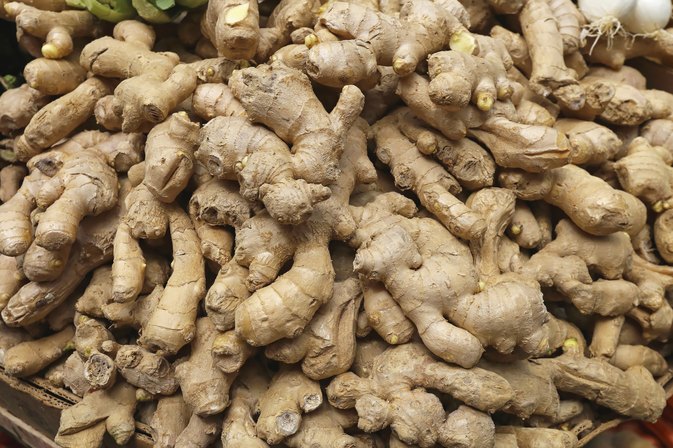Author
by
https://www.livestrong.com/article/522845-ginger-root-and-potassium/
by
Ginger root, the underground rhizome from the tropical Zingiber officinale plant, has been used since antiquity as a food and herbal medication. Ginger is revered in Ayurveda and Traditional Chinese Medicine for its carminative, or gas-reducing, and anti-inflammatory properties. Western herbalists recommend the herb for digestive complaints, motion sickness, and postsurgical nausea. The tan, pungent-smelling roots feature a distinctive, refreshing taste, and they are used to flavor baked goods, soft drinks and teas. Ginger root contains assorted vitamins and minerals, including potassium. Consult your doctor before taking ginger root.
Features
Potassium is an essential mineral and a vital electrolyte, which is a fluid that helps transport electricity through the body. It is the major positive ion, or cation, found inside the cells, and it works along with sodium, chloride, calcium and magnesium to conduct electricity. The correct balance of electrolytes is essential for nerve impulse transmission, proper regulation of your heart rate, and contraction of skeletal and smooth muscles, including those in the cardiovascular and digestive systems. Good sources of dietary potassium include meats, poultry, dairy products, citrus fruits, bananas and leafy green vegetables. According to the Institute of Medicine, adults should get 4,700 mg of potassium a day. The Linus Pauling Institute at Oregon State University notes that a potassium-rich diet may be linked to a reduced risk of stroke, high blood pressure, osteoporosis and kidney stones.
- The Basics
A 2-tsp. serving of fresh, chopped ginger root contains .07 g of protein, .03 g of total fat, .71 g of carbohydrates, .1 g of fiber and .07 g of natural sugars. With a negligible 3 calories, a serving of ginger is low-calorie, low-salt, low-fat, high-fiber and cholesterol-free. Along with vitamins and minerals, ginger root contains essential fatty acids such as linolenic acid. The active constituents of ginger -- shagaols, gingerols and zingiberene -- have therapeutic properties, which may include the ability to reduce inflammation and reduce the stickiness of blood platelets, helping to lower risk of atherosclerosis.
Potassium in Ginger
With 415 mg of potassium in every 100 g, or roughly 3 1/2 oz., ginger root contains a higher percentage of potassium than bananas, which offer 358 mg per 100 g. However, ginger root is normally eaten in such small amounts that you can't rely on it to make a substantial contribution toward your recommended value. The Commission E -- a European herbal regulatory agency -- recommends taking no more than 4 g, or 2 tsp., of fresh ginger root a day, an amount that provides 17 mg of potassium, or less than 1 percent of the daily value. Ginger root also contains modest amounts of trace minerals, with 2 tsp. providing .02 mg of iron, which is needed for oxygen transport, as well as .01 mg of zinc, which is essential for wound healing. Copper and manganese are also present in ginger in small quantities.
Usage and Considerations
Select firm, compact ginger roots that feel heavy for their size, with intact tan or yellowish-gray peel and creamy white or yellow interiors. Ginger root can be stored in the refrigerator for up to one month. Although ginger is generally recognized as safe when used as a food, large amounts can cause heartburn, diarrhea and mouth irritation. Allergic reactions to ginger have been reported. Consult your doctor before using ginger root. If you are pregnant or breast-feeding, you have gallstones, or you take blood-thinning medications, don't use ginger root.
https://www.livestrong.com/article/522845-ginger-root-and-potassium/







No comments:
Post a Comment